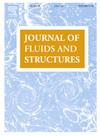Flow-induced vibration of an underwater lazy wave cable in unidirectional current
IF 3.5
2区 工程技术
Q1 ENGINEERING, MECHANICAL
引用次数: 0
Abstract
This paper describes measurements of the flow-induced vibration of an instrumented model cable in a lazy wave configuration immersed in unidirectional currents in the 2 m deep FloWave Facility at the University of Edinburgh. The cable model, designed to represent a dynamic power cable used in offshore renewable energy structures for electricity transmission, has an external diameter (D) of 31 mm and a mass ratio of 1.22. The current speed was varied from 0.1 to 0.9 m/s and its direction was set at 0, 90, and 180 degrees relative to the initial longitudinal axis of the cable. An underwater Qualisys motion capture system measured the in-line (IL) and cross-flow (CF) displacement components at 36 locations along the length of the submerged cable. Local displacements, response frequencies, and travelling wave modes are determined for reduced velocity Ur ϵ (5.29, 47.69), and Reynolds number Re ϵ (103, 104). It is found that the root mean square (RMS) values of the displacement components exhibited an increasing trend with reduced velocity reaching 0.40D in the in-line direction and 0.45D in the cross-flow direction. For reduced velocity in the range from 5.29 to 10.58, the cable exhibited single frequency vibrations. For Ur > 10.58, the cable experienced broad-banded, multi-frequency responses. Along the cable, certain locations were found to execute distinct circular, elliptical, nearly linear, and figure-of-eight orbits at low Ur. A sudden phase shift was observed along the cable length, related to unsteady vortex-induced vibration (VIV), which effectively prevented lock-in occurring at high Ur.
单向电流作用下水下懒波电缆的流激振动
本文描述了在爱丁堡大学2米深的FloWave设施中,浸入单向电流的懒波配置中,仪器模型电缆的流激振动测量结果。该电缆模型旨在代表用于海上可再生能源结构的电力传输的动态电力电缆,外径(D)为31毫米,质量比为1.22。电流的速度在0.1 ~ 0.9 m/s之间变化,方向分别设置为相对于电缆的初始纵轴0度、90度和180度。水下Qualisys运动捕捉系统沿着水下电缆的长度测量了36个位置的在线(IL)和横流(CF)位移分量。局部位移、响应频率和行波模式被确定为降低速度Ur λ(5.29, 47.69)和雷诺数Re λ(103, 104)。结果表明,位移分量的均方根(RMS)值呈增加趋势,直线方向的速度减小为0.40D,横流方向的速度减小为0.45D。在5.29 ~ 10.58的速度范围内,电缆呈现单频振动。对于Ur >;10.58时,电缆经历了宽频带多频响应。沿着电缆,某些位置被发现执行不同的圆形,椭圆形,近线性和低Ur的8字形轨道。沿电缆长度观察到一个突然的相移,与非定常涡激振动(VIV)有关,这有效地防止了在高Ur时发生锁相。
本文章由计算机程序翻译,如有差异,请以英文原文为准。
求助全文
约1分钟内获得全文
求助全文
来源期刊

Journal of Fluids and Structures
工程技术-工程:机械
CiteScore
6.90
自引率
8.30%
发文量
173
审稿时长
65 days
期刊介绍:
The Journal of Fluids and Structures serves as a focal point and a forum for the exchange of ideas, for the many kinds of specialists and practitioners concerned with fluid–structure interactions and the dynamics of systems related thereto, in any field. One of its aims is to foster the cross–fertilization of ideas, methods and techniques in the various disciplines involved.
The journal publishes papers that present original and significant contributions on all aspects of the mechanical interactions between fluids and solids, regardless of scale.
 求助内容:
求助内容: 应助结果提醒方式:
应助结果提醒方式:


